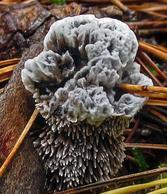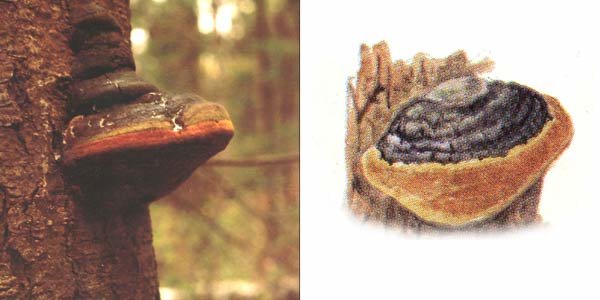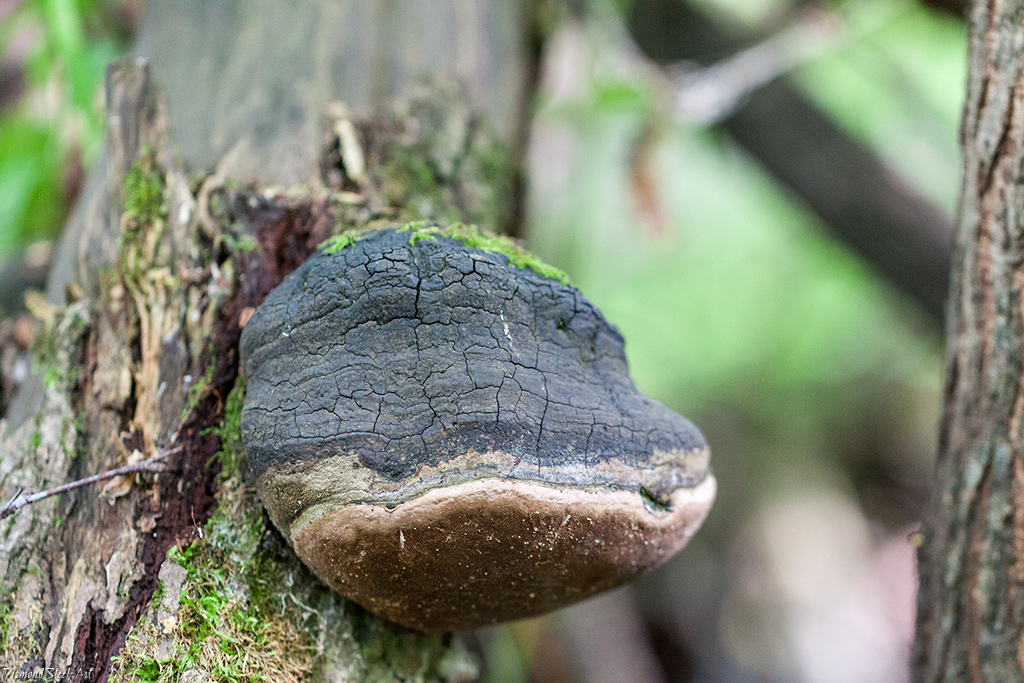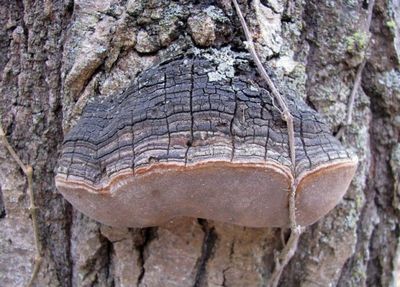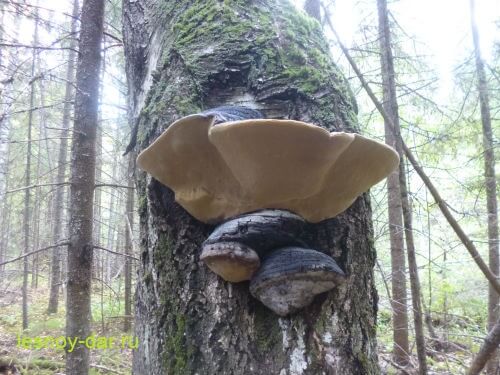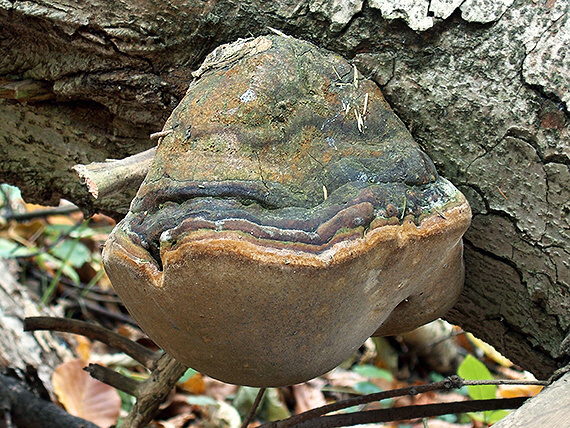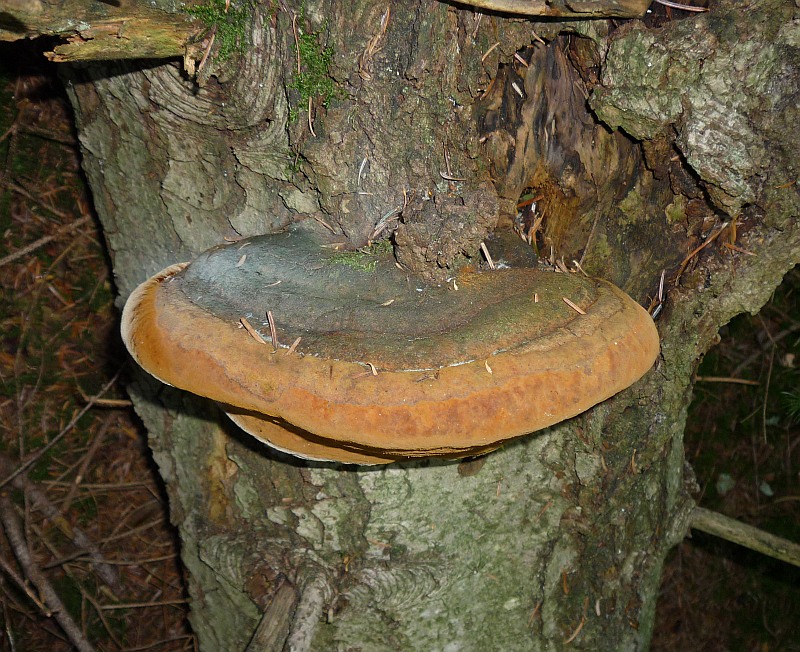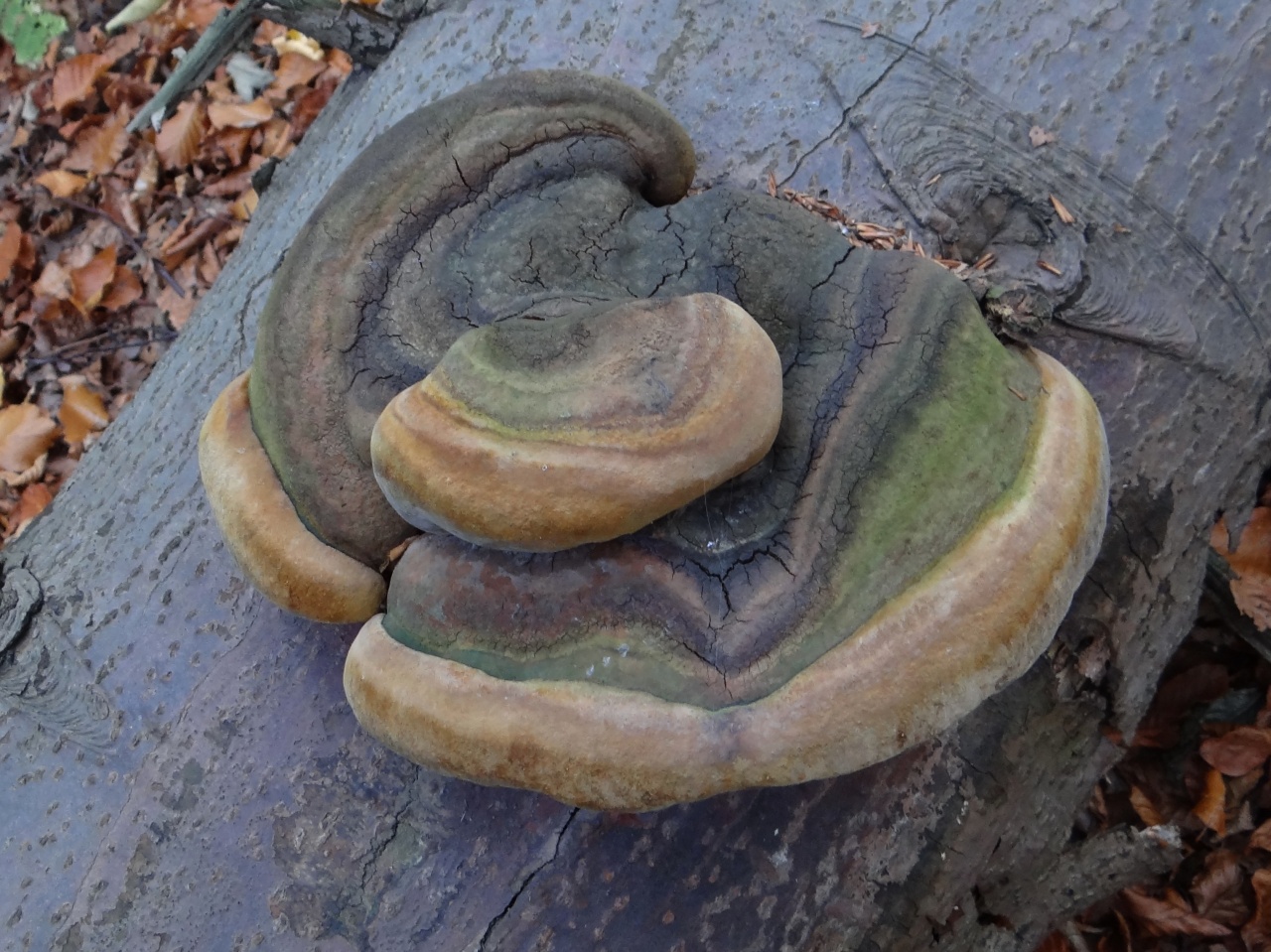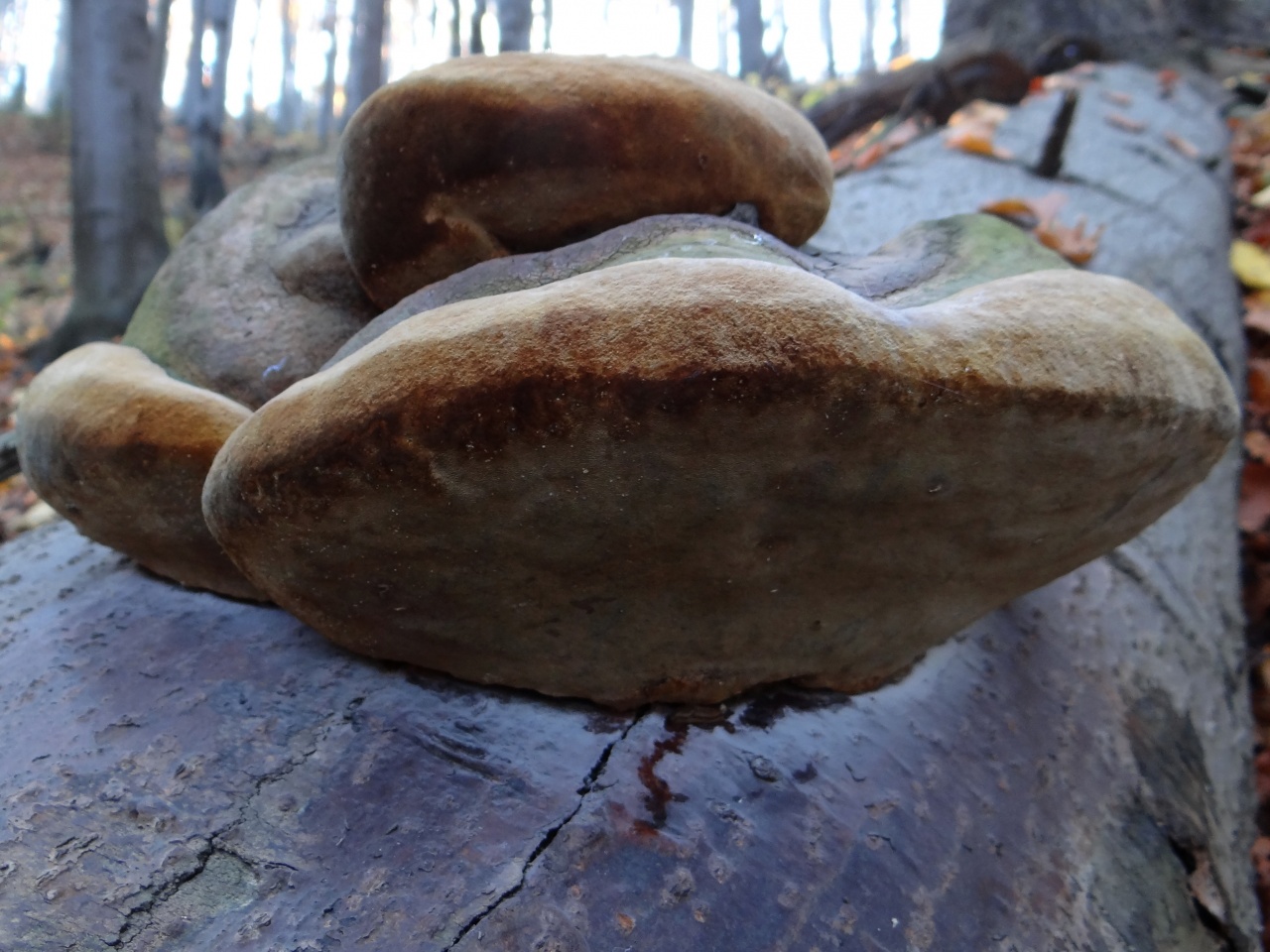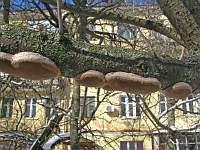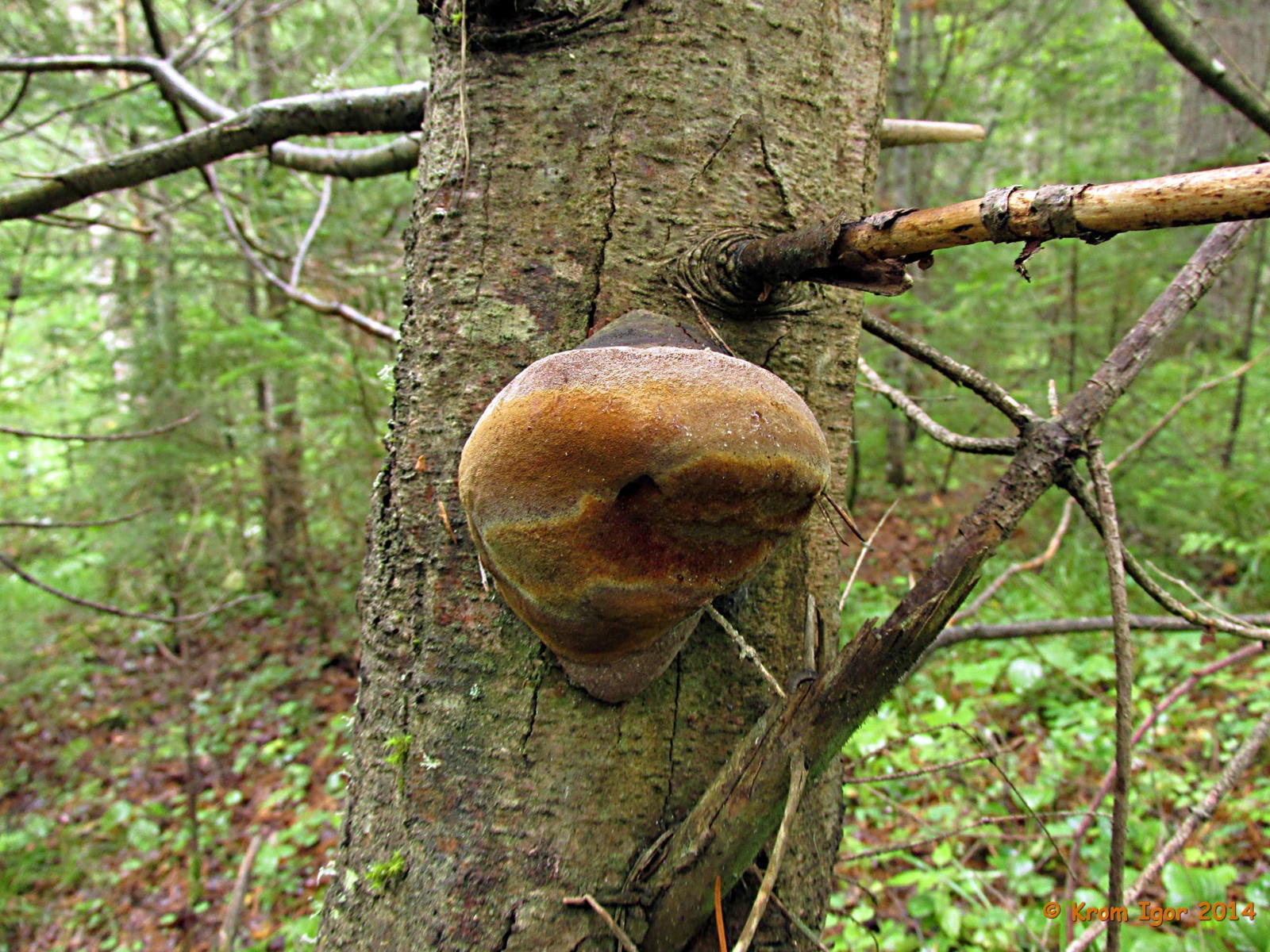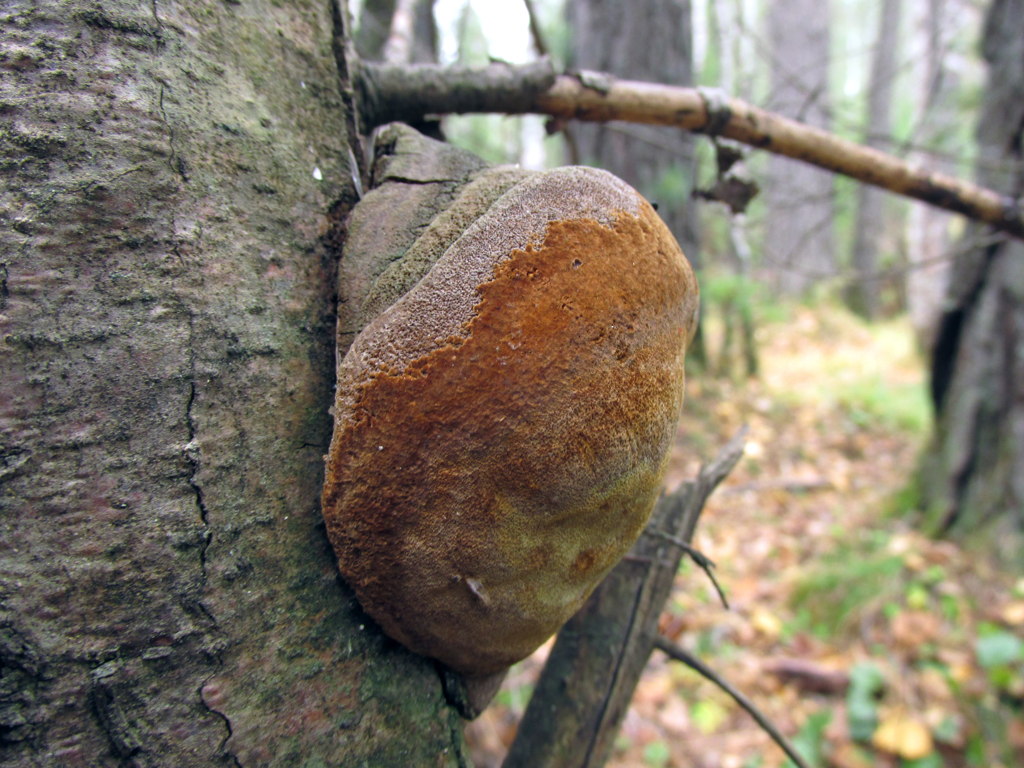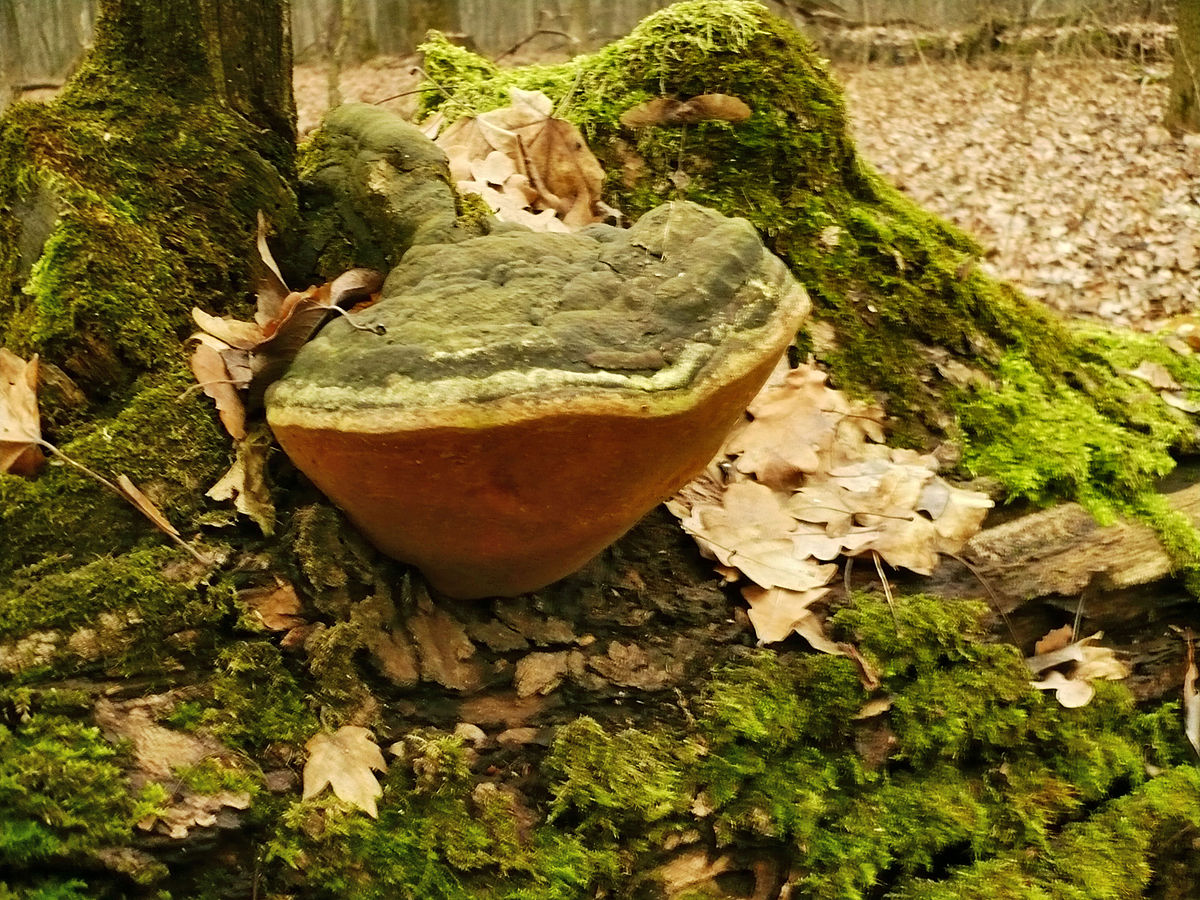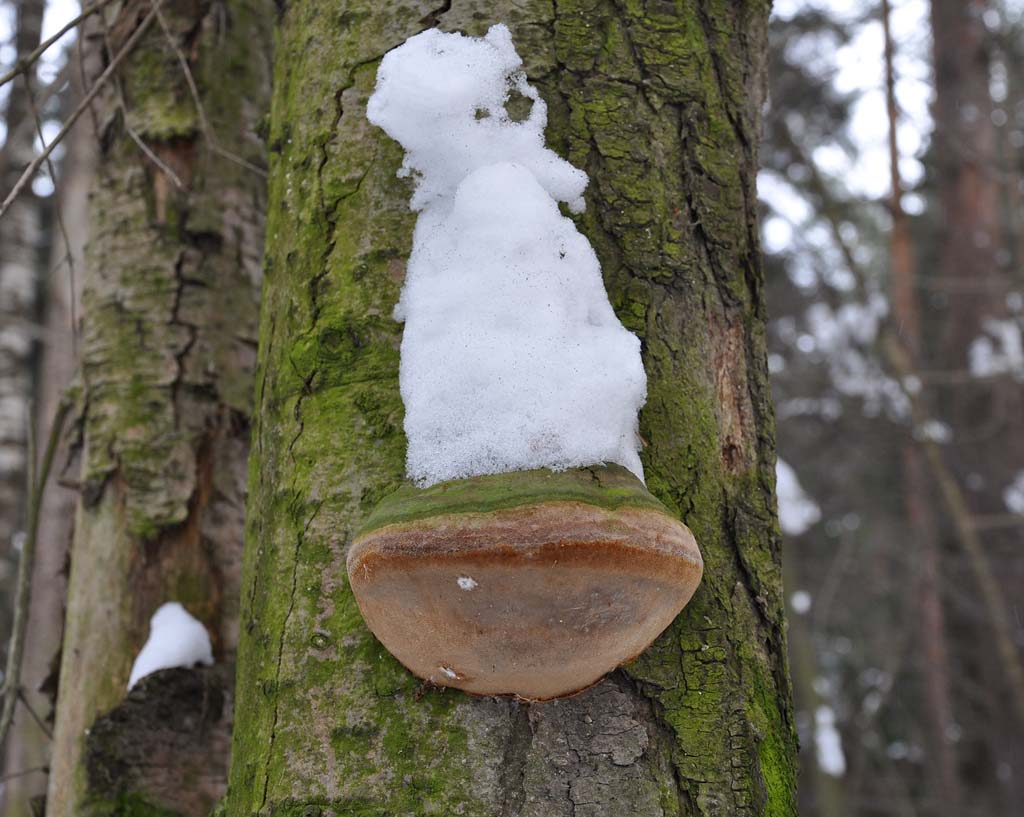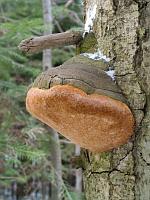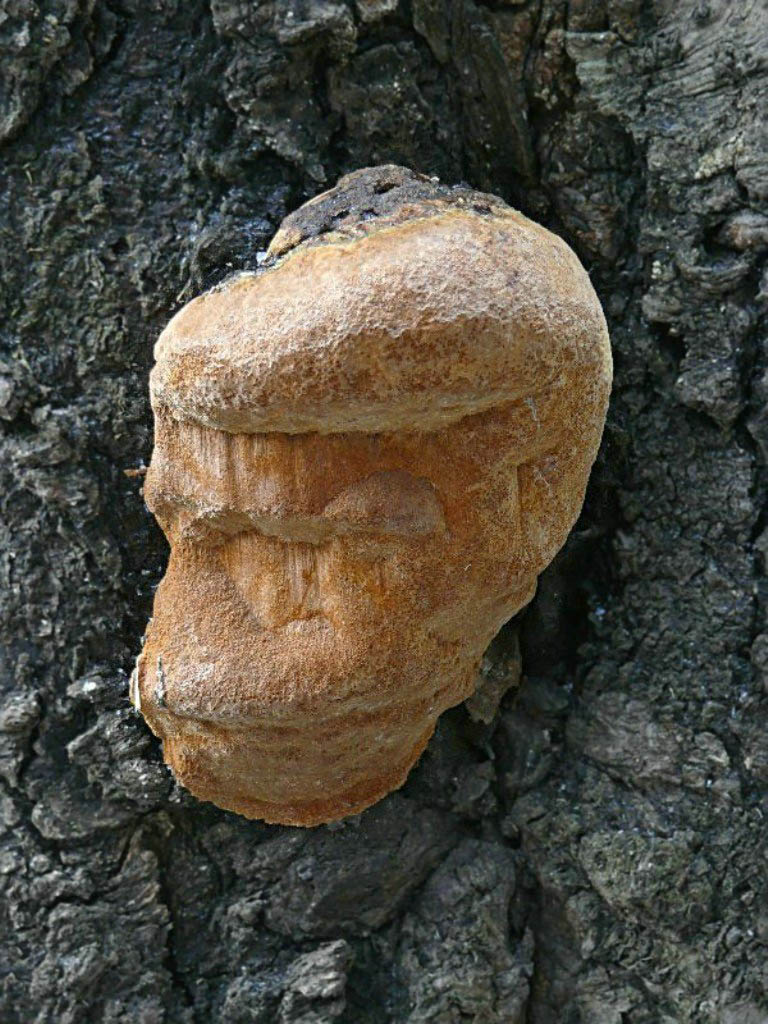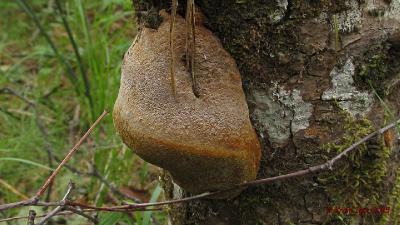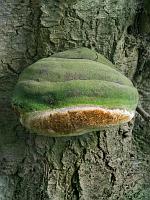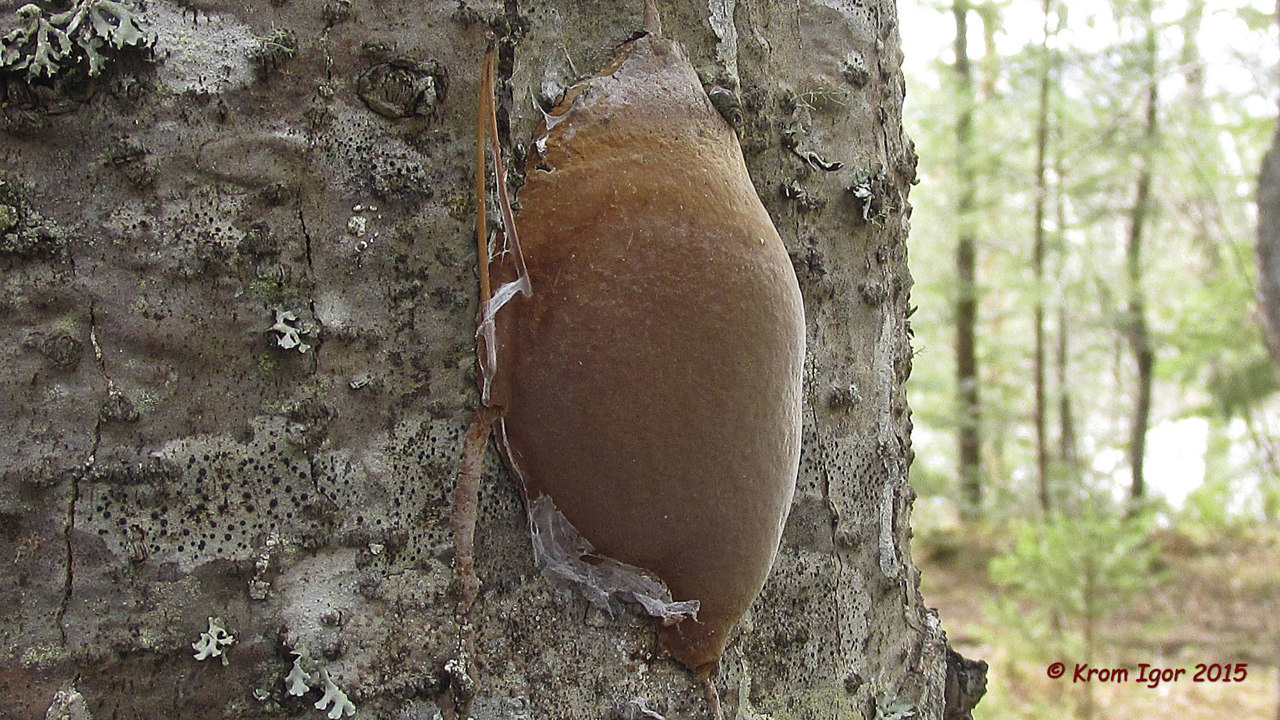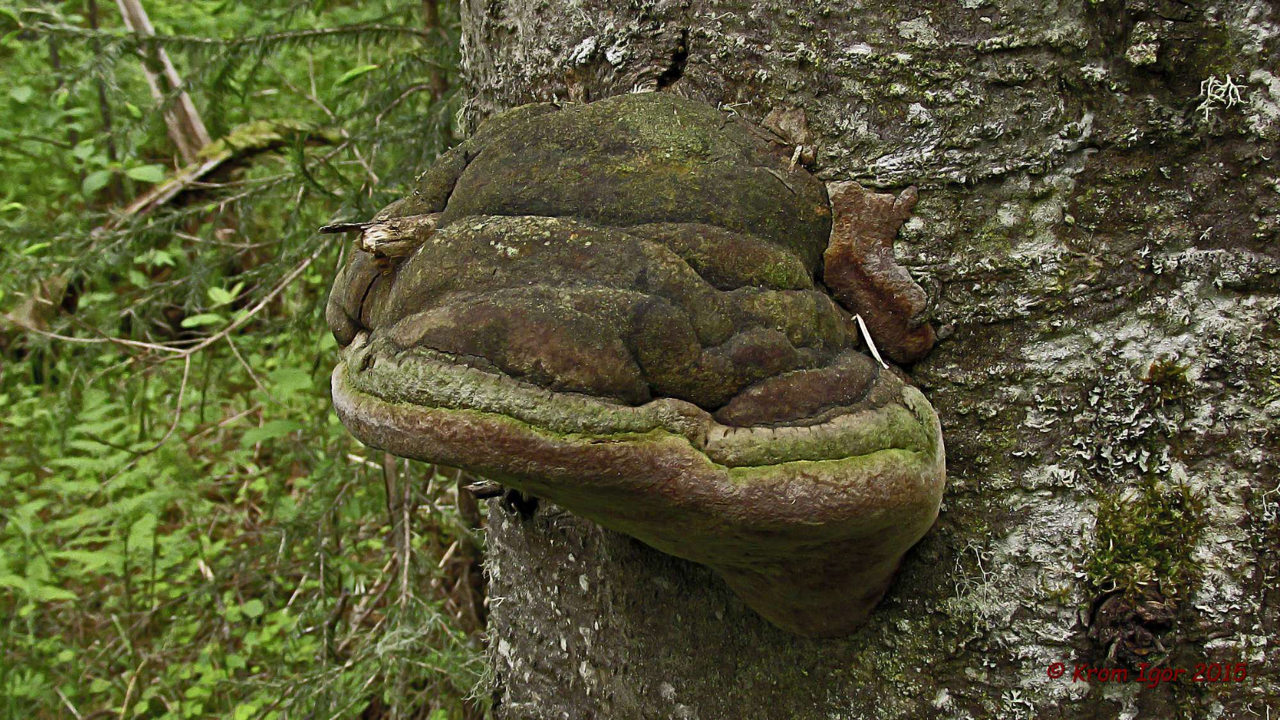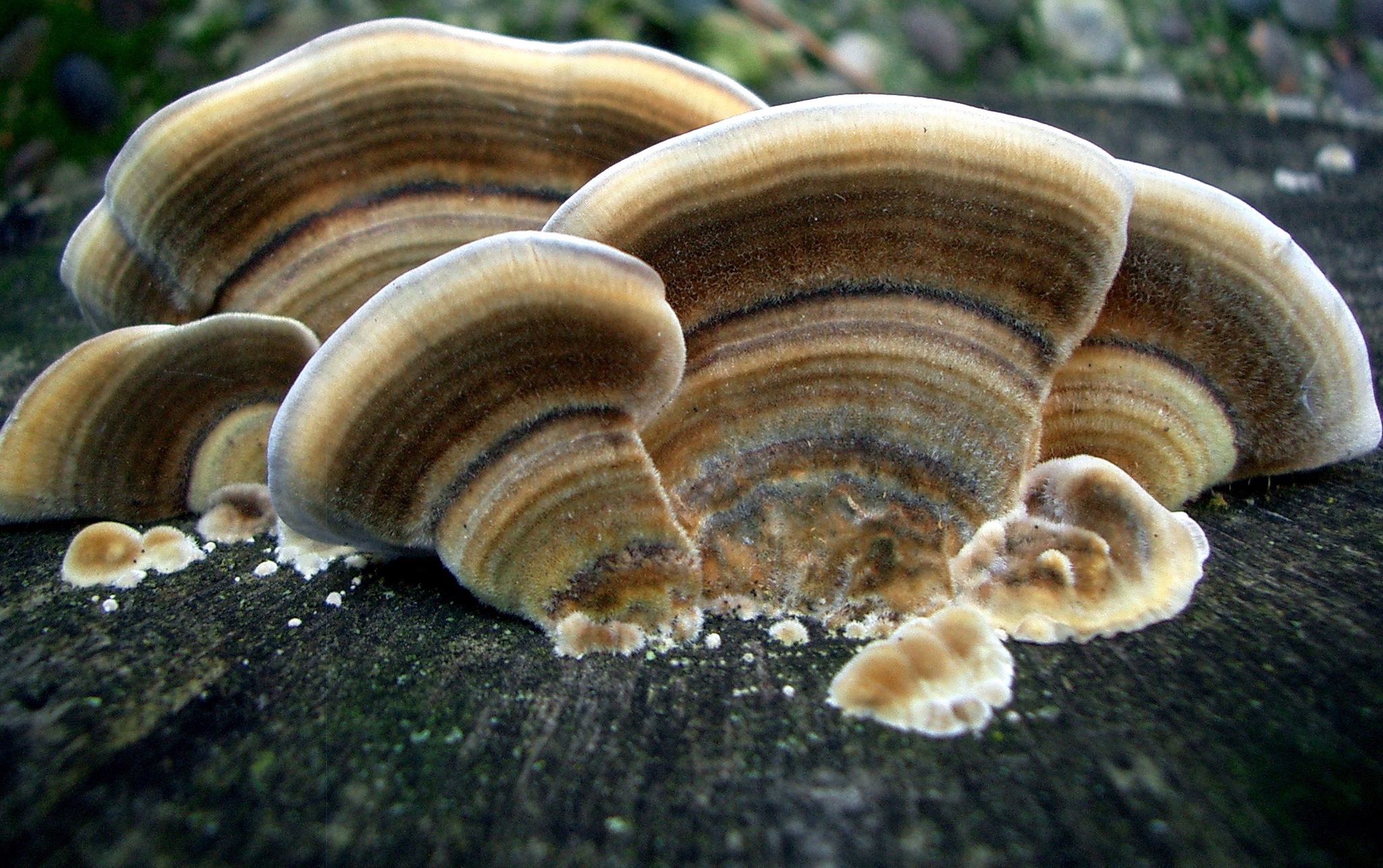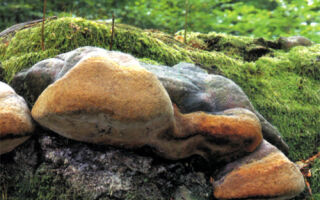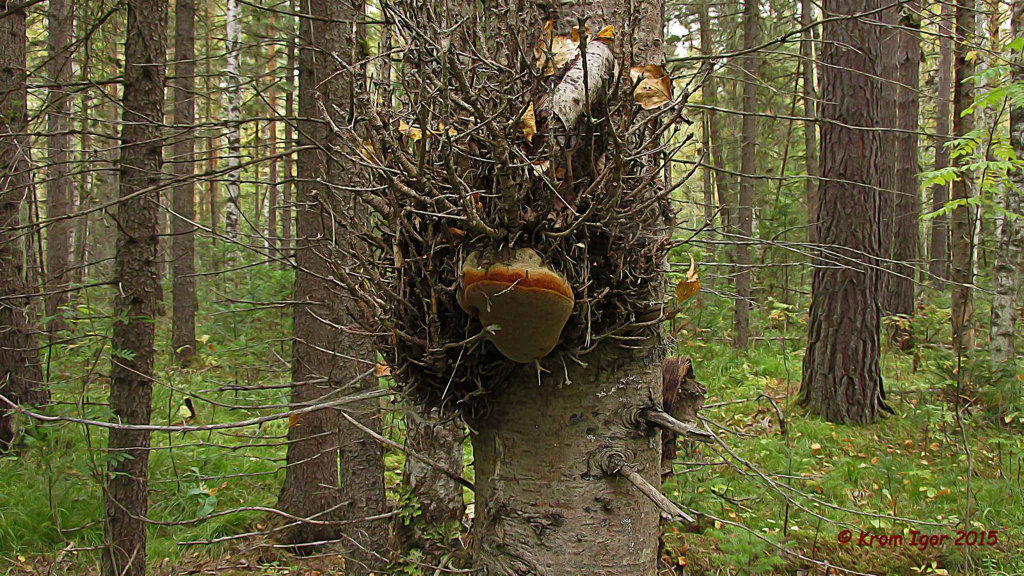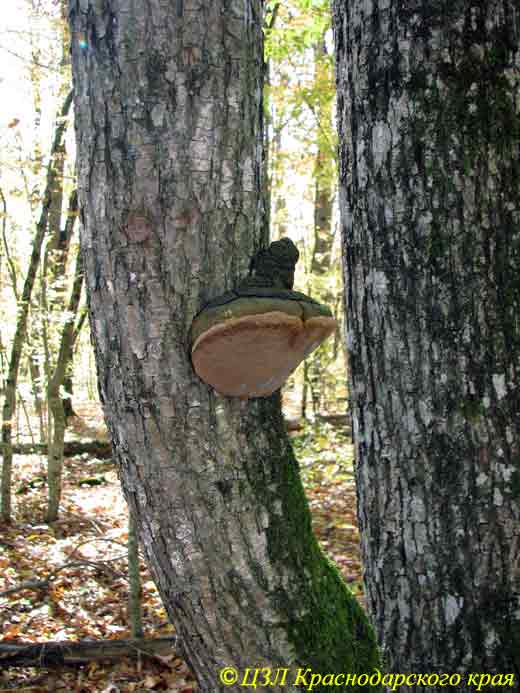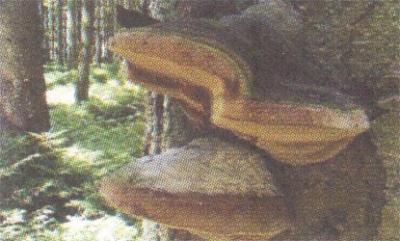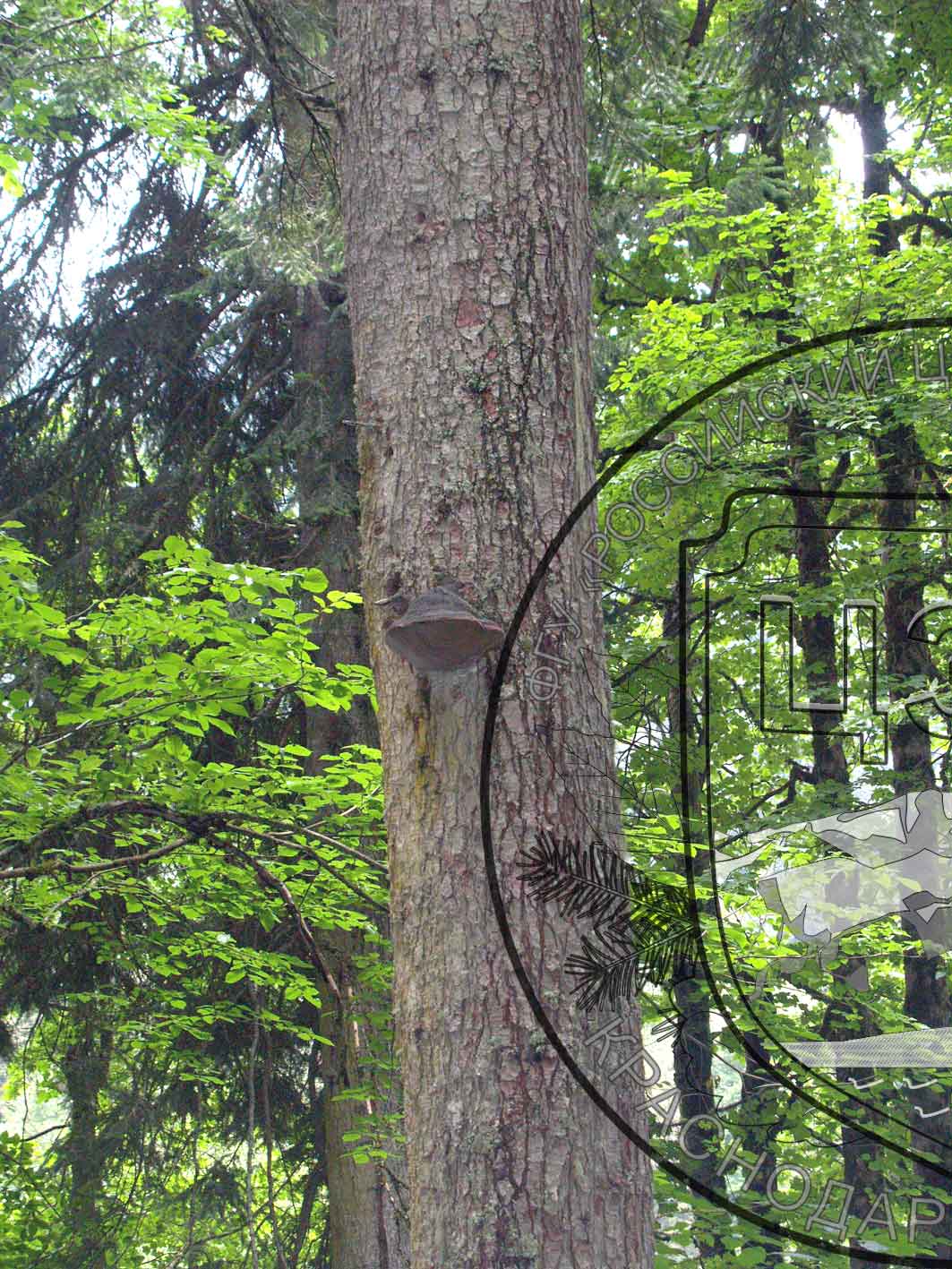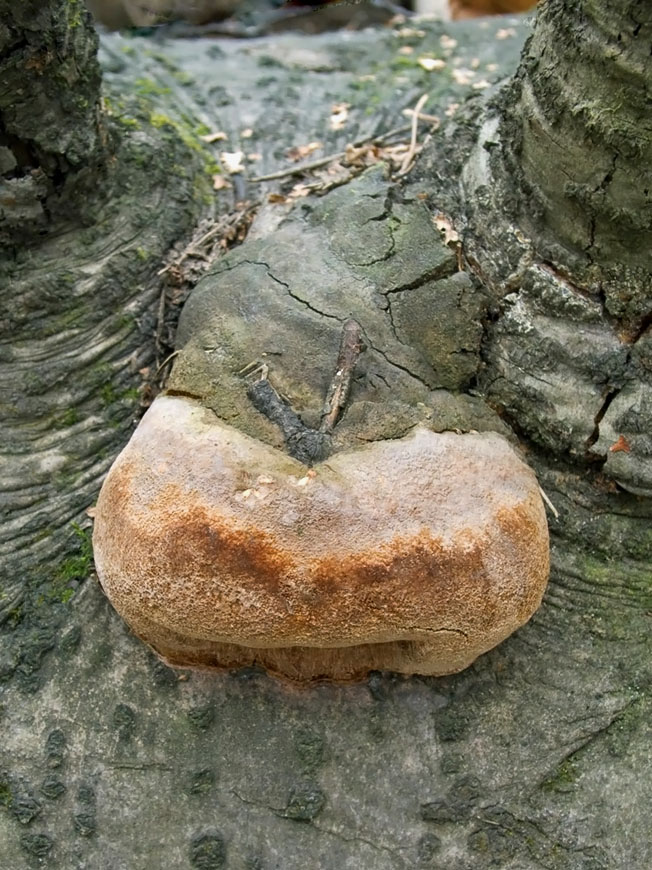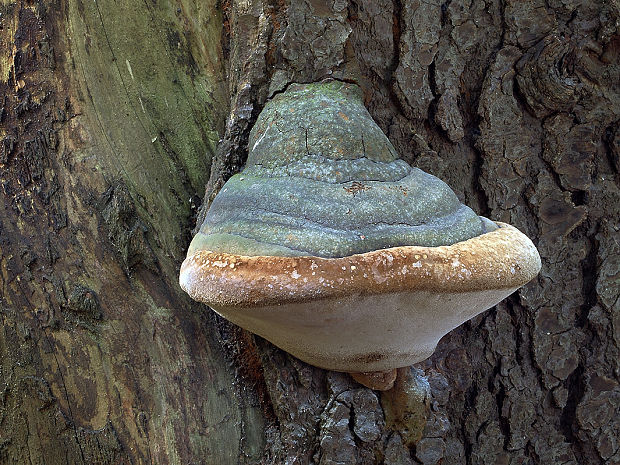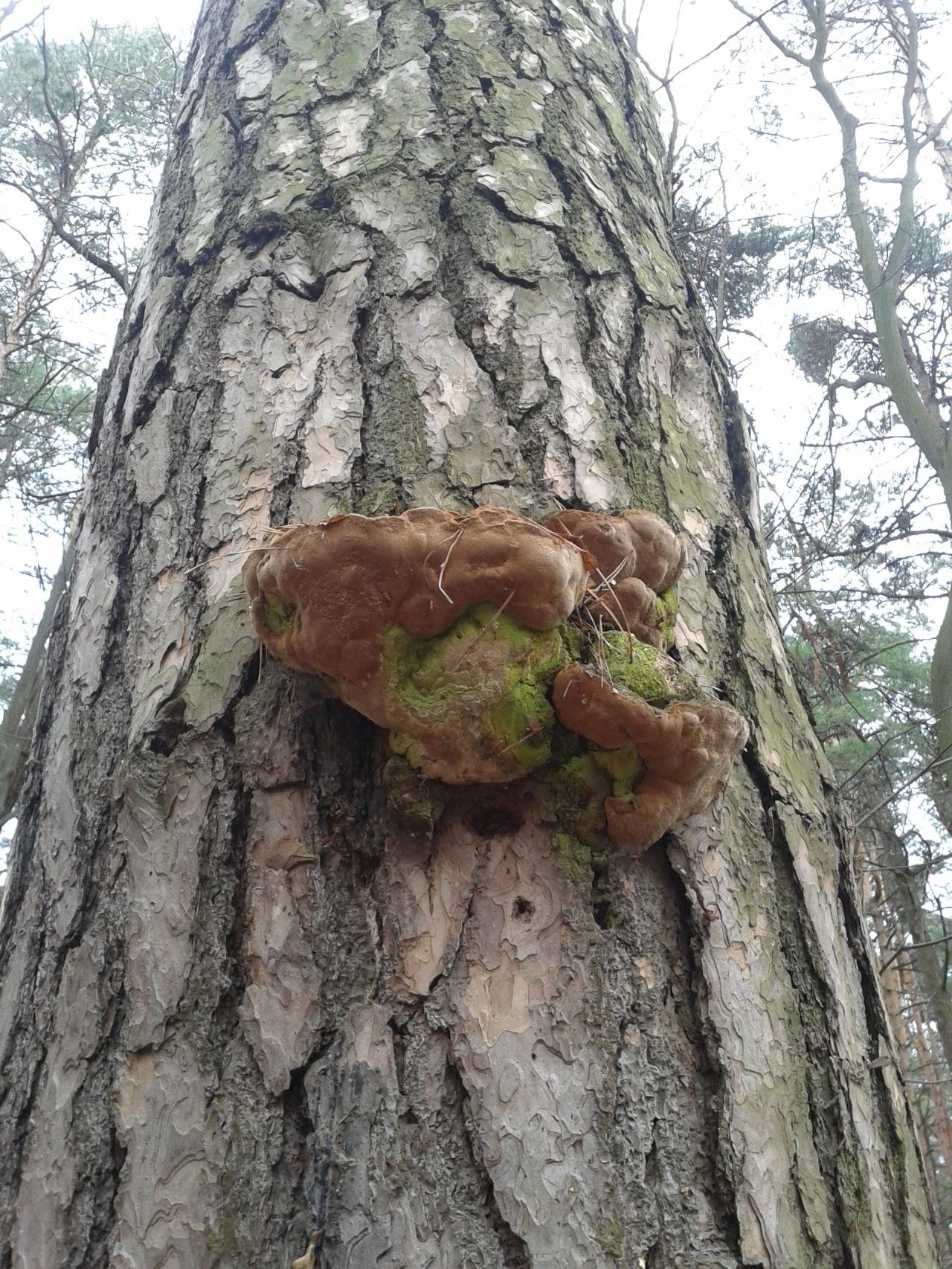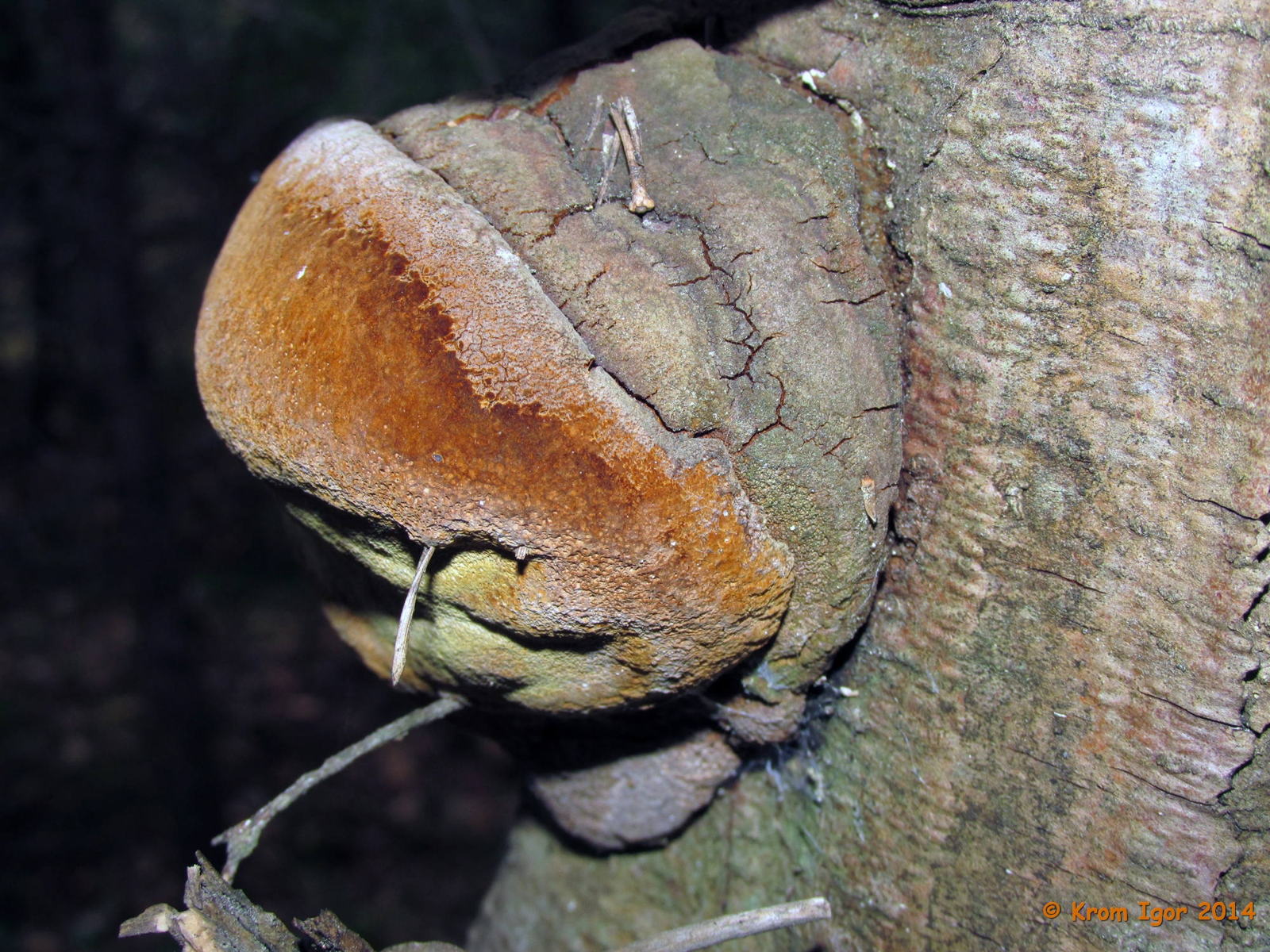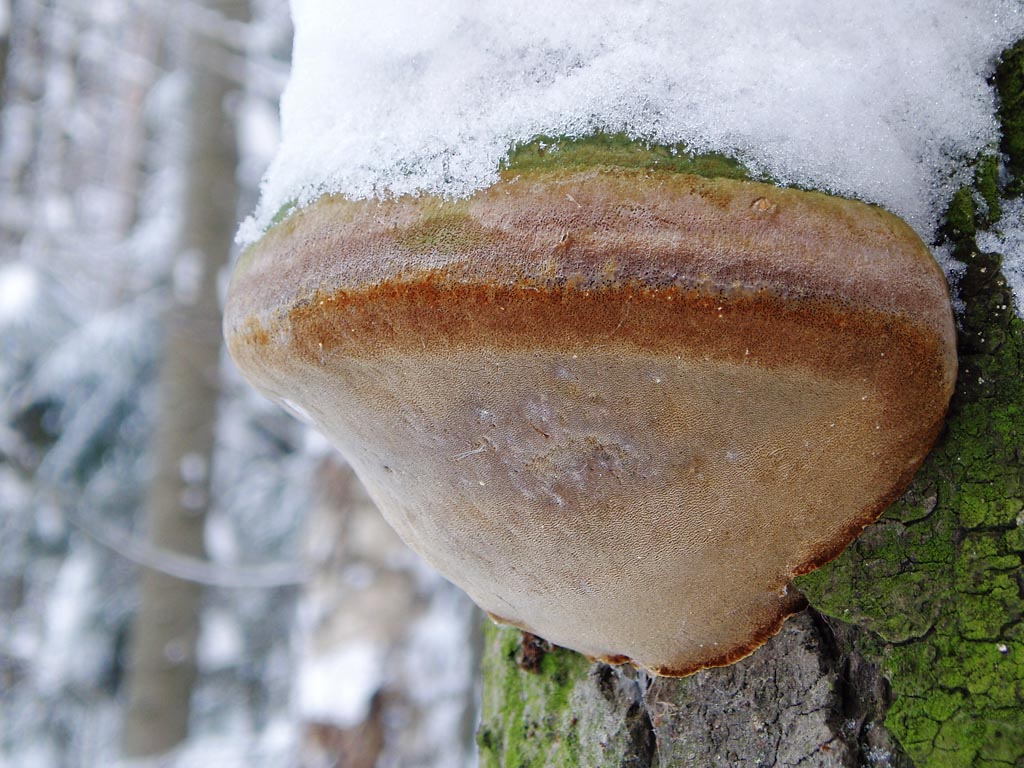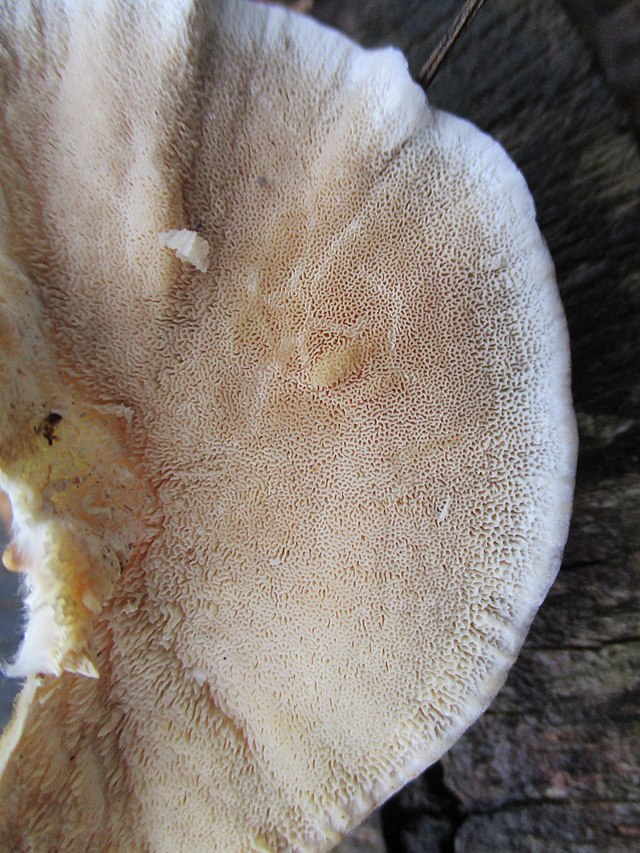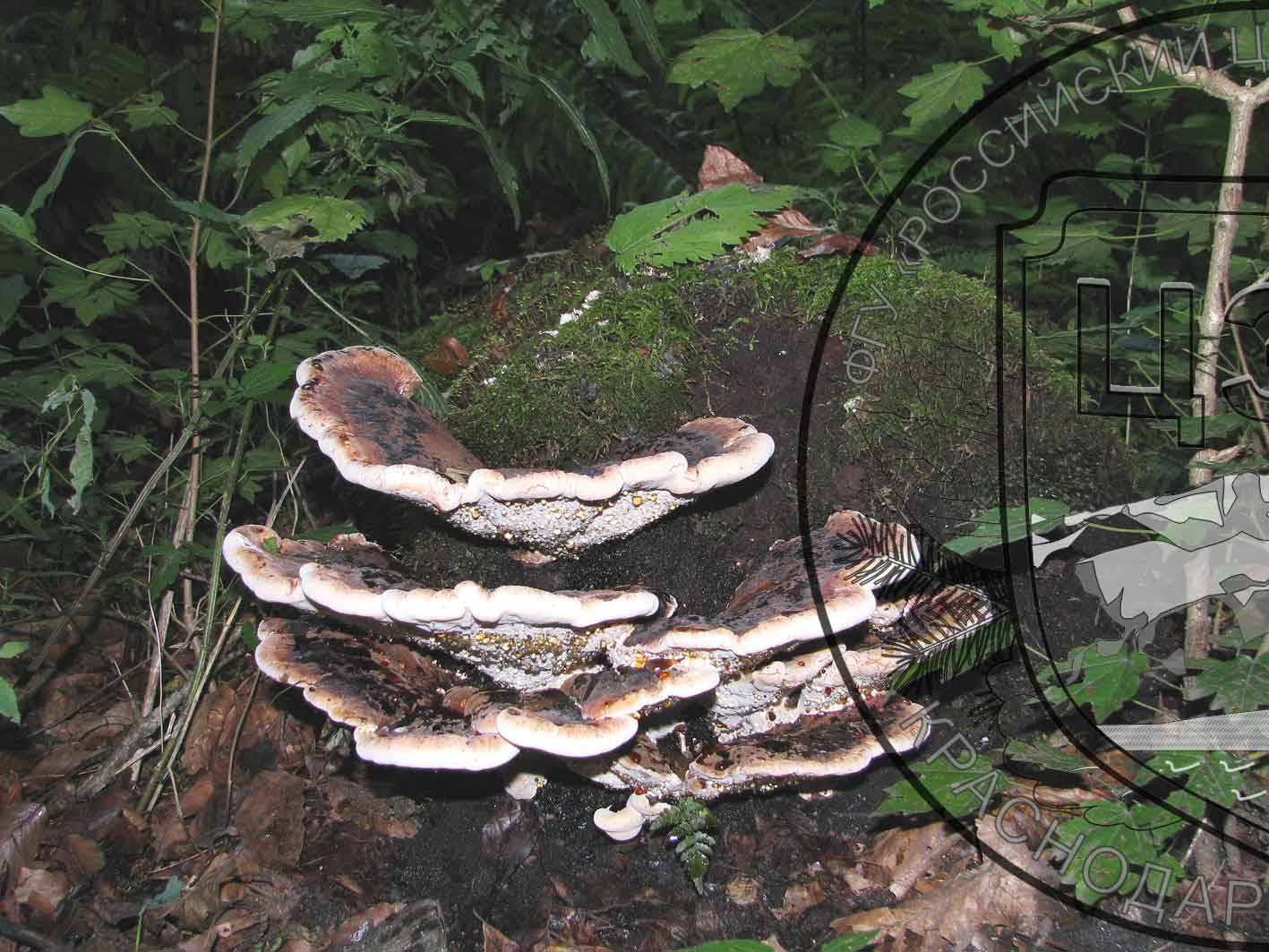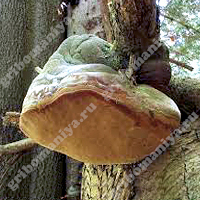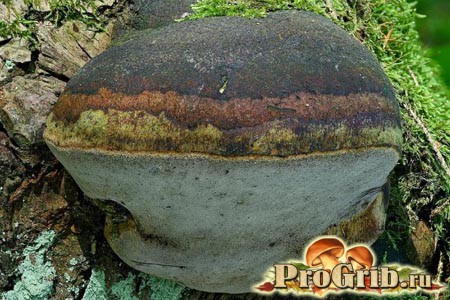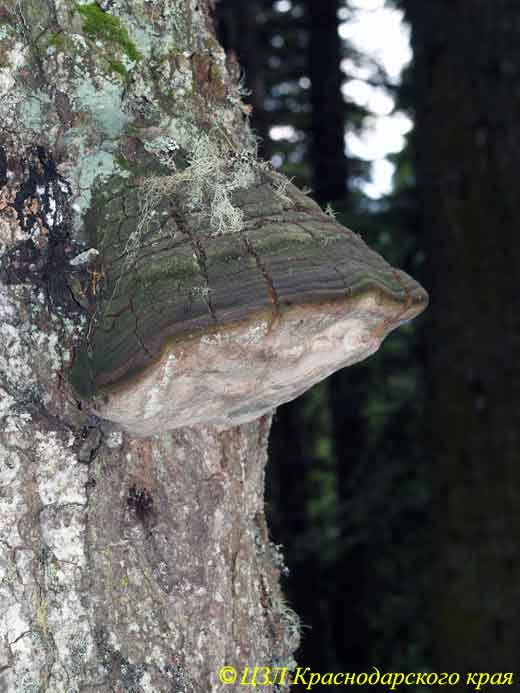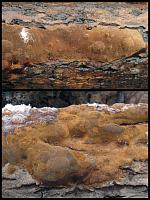Literature
- Bondartsev A.S. Polypore mushrooms of the European part of the USSR and the Caucasus. - M .: Publishing house of the USSR Academy of Sciences, 1958 .-- P. 349-356
- Mushrooms of the USSR / M. V. Gorlenko, M. A. Bondartseva, L. V. Garibova, I. I. Sidorova, T. P. Sizova. - M .: Mysl, 1980 .-- P. 125
- Pelle Jansen All about mushrooms. - SPb .: Crystal. - P. 120
- Cheremisinov N.A., Negrutsky S.F., Leshkovtseva I.I. Fungi and Fungal Diseases of Trees and Shrubs: A Handbook for Identifying Fungi by Host Plants. - M .: Lesnaya promyshlennost, 1970 .-- P. 91, 193
- Encyclopedia of Forestry: in 2 volumes. - T. 1. - M .: VNIILM, 2006 .-- P. 420
Everyone knows that there are edible and inedible mushrooms. But there are those that even bring harm, causing rot on trees. Such a mushroom, capable of living for about 80 years, being a permanent inhabitant of our forests, will be discussed in this article.
Description of tinder Gartig
At first, the shape of the fruiting body is nodular, over time it becomes cantilever. The mushroom is attached to the tree with its wide base. The fruit bodies of Gartig tinder fungi are quite large - the diameter reaches 28 centimeters, and the thickness is 20 centimeters.

The upper surface of the mushroom is rough. Wide zones are highlighted, located in steps. The color of the mushroom is first yellow-brown, then it changes and becomes dirty gray or black. In mature Gartig tinder fungi, the surface cracks and green algae appears on it. The edge of the fruiting body has a rounded shape. The color of the edge is ocher brown or reddish.
The pulp of the mushroom is zoned, very tough, with a woody texture. At the break, the pulp acquires a silky sheen. The color of the pulp is yellow-brown or yellow-rusty. The tubes are arranged in several layers. The tubular layers are separated by sterile layers. The color of the tubes is rusty brown. The pores are round or angular.

Spread of Gartig's tinder fungus
Gartig's polypores grow in coniferous forests. These mushrooms settle on conifers, they are mainly found on fir trees. Fruiting bodies are most often formed in the lower part of the trees, on the north side. Fruiting bodies appear singly. These are perennial mushrooms. Sometimes several fruiting bodies grow together.
Similarities between Gartig tinder fungi and other mushrooms
Tinder fungus Gartig is similar to the false oak tinder fungus, which develops on oak trees. The difference lies in the places of growth and in the fact that the Gartig tinder fungus has sterile layers between the layers.

Influence of Gartig's tinder fungi on trees
Gartig's polypores cause pale yellow rot. There are narrow black lines around the edges of this rot that delimit it from healthy wood.
Gartig's polypores are dangerous pests of the fir. Infection of trees occurs through other plants and broken off branches. At the initial stage of infection, the wood becomes soft, fibrous. Under the bark, the mycelium of the fungus is brown in color, rotten branches become noticeable on the tree. Over time, depressions form on the surface of the trunk, in which fruiting bodies develop.
Trees infected with these parasitic fungi are scattered in fir forests singly. More than 40% of affected trees can be observed in foci of infestation. The risk of infection is especially high in old fir stands. Thicker trees are most often infested.

Other polypores
Cellular polypore is an edible species. His hat is medium in size - up to 8 centimeters, its shape is oval and round. The color of the cap is pale yellow, red-yellow or ocher-yellow. There are darker scales on the surface of the cap. The stem is very short, and some specimens do not have it at all. Its height is no more than 10 millimeters.The leg is smooth, it is mainly located on the side, its color coincides with the cap. The flesh is very tough, white in color.
Cellular polypores grow on the dead wood of deciduous trees. The fruiting period is April-August. They settle mainly in small groups, but they also come across singly. Although these mushrooms can be eaten, they are very tough.

Smoky tinder fungus is an inedible species. The hat is thick - its thickness reaches 2 centimeters, and the diameter is about 12 centimeters. The color of the fruiting body is yellowish, and with aging it becomes brown. The edges of the mushroom are blunt at first, and with age they sharpen. Young fruit bodies are very loose.
Smoky polypores grow on stumps and rotten wood. They feed on the decomposition of trees, but can parasitize living trees. They bear fruit from spring to autumn. These are inedible wood-destroying mushrooms.
Antineoplastic substances of Oak Tinder.
Work on the identification of substances in Tinder Oak, which give the mushroom such antitumor power. Such substances were polyphenols Hispolon and Styrylryrone, triterpenes and betaglucans of the fungus. Now about each of them in order: Polyphenols of the mushroom. Hispolon Thus, at the Taiwan Institute of Chinese Pharmaceutical Sciences, Dr. Huang G.J. In 2010, he isolated an interesting substance from a mushroom - Hispolon, a phenolic compound that inhibits the growth of cancer cells, prevents them from multiplying, disrupts cell division, disrupts the production of proteins necessary for cell division, and causes normal cell death of a cancer cell - apoptosis. It also has anti-inflammatory and antioxidant properties. The conclusions of the work are the suppression of mobility and the ability of cancer cells to penetrate into healthy tissues, suppression of metastases. Here is the first anti-tumor agent that Dr. Song observed. Dr. Lu N.L. came to similar conclusions. from the Faculty of Pharmacy, China Medical University in Taichung, Taiwan. He studied Hispolon's effects on breast and bladder cancer and wrote about the powerful anti-tumor activity of this substance. Chen W. from Zhejiang University, Hangzhou, China, also investigated Hispolon in gastric cancer and revealed specific mechanisms of its work - an increase in apoptosis and an increase in the ability of chemotherapy to damage cancer cells while reducing its side effects. Styrylpyrone Dr. Lee I.K. from Chonbuk National University, Korea, found in a mushroom an analogue of plant flavonoids - a yellow polyphenol pigment - Styrylpyrone, which has the following properties: - direct damaging effect on cancer cells - antioxidant - prevents the formation of blood clots - antiviral - antidiabetic - anti-inflammatory. But the most powerful property of Styrilpirone is its direct damaging effect on cancer. Mushroom betaglucans. Chen L. From Changchum Jilin Agricultural University, China, in 2011 investigated the effect of fungal glucans on sarcoma and liver cancer in mice, and revealed inhibition of cancer cell growth, prolongation of life span, increased levels of cytokines - Interleukins 2 and 18 Yang Y. from the Institute An edible mushroom in Shanghai, in 2009, revealed the heteropolysaccharide PISP1, which stimulated the proliferation of lymphocytes in the spleen of mice. macrophages and cytotoxic T-lymphocytes). In addition, betaglucans also cause cancer cell death through apoptosis (normal cell death). Fungal triterpenoids. Fungal triterpenoids are a new word in the development of oncology - if the betaglucans of fungi were discovered and studied a long time ago - from the end of the 60s of the last century, then triterpenes - only recently - from the beginning of 2000.Triterpenes are amazing substances (except for Fellinus were discovered in Reishi and in the Red Camphor Mushroom) capable of killing human cancer cells. They restore and activate the normal death of cancer cells (which does not occur - after all, cancer cells are practically immortal), as a result of which most of the cancerous tumor dies. Prof. Wang G.J. from the National Research Institute of Chinese Medicine in Taipei, Taiwan. In 2009, he found and isolated new fungal triterpenoids from Fellinus - Lanostanol igniaris A, B, C and D (Lanostanol igniares A, B, C, D), which activated Macrophages. Working with these triterpenes, he proved their high activity against prostate and stomach cancer. Conclusions: Now it has become clear that with a large number of anticancer substances, Fellinus oak has become one of the few very powerful drugs in Chinese traditional medicine against cancer. Currently, it is used not only by traditional healers in Taiwan, Korea and China, but also by doctors in oncological hospitals. And all this thanks to the work of the Joint Thai-Korean Center for Research on Fellinus Mushrooms, for which they are very grateful.
Destruction of wood
Drying of trees in the foci of the root sponge
Rotting wood is the process of its decomposition and destruction by wood-destroying fungi using a specific set of enzymes (substances that convert complex organic compounds into water-soluble, easily digestible by the fungus).
The nature of the destruction depends on the type of fungus and its set of enzymes, the degree and sequence of its destruction of cell walls, changes in the chemical composition of wood pulp and its physical properties. There are destructive and corrosive types of decay.
In the destructive type, decomposition of cellulose and hemicellulose occurs, which are the main constituent part of the cell walls and provide mechanical strength and elasticity of wood tissues. The cell membranes are destroyed evenly, gradually, without the formation of large holes in them. The fungus affects the entire mass of wood. As a result, the entire volume of the wood decreases, numerous cracks appear in it. Subsequently, the wood disintegrates into prismatic pieces, becomes brittle, and is easily ground into powder. The color of the wood is also gradually changing. At first, it becomes reddish, later turns brown, and in the final stage it acquires a dark brown color. Rot of this type is caused by the Swiss tinder fungus, sulfur-yellow tinder fungus, bordered tinder fungus, larch sponge and birch sponge, etc.
With a corrosive type of decay, lignin (an organic compound that causes lignification of the cell walls) and partially the cellulose complex are destroyed. Some fungi simultaneously decompose lignin and cellulose, destroying groups of cells in separate places. In the affected wood, cavities appear in the form of pits and cells, filled with white undecomposed cellulose. White spots of cellulose on a brown wood background create a variegated rot color (variegated corrosive rot). Variegated corrosive rot is caused by a root sponge, a pine sponge and a sponge sponge, spruce butt tinder fungus and oak tree tinder fungus.
Corrosive rot from root sponge
Other types of fungi initially completely decompose lignin, and then cellulose and other polysaccharides are gradually destroyed. At the same time, in the final stage of decay, the affected wood brightens evenly or in stripes, acquires a white, light yellow or "marble" color (white corrosive rot). White corrosive rot is caused by autumn honey fungus, real tinder fungus, false tinder fungus, flat tinder fungus.
Root rot is the most dangerous for growing trees, causing them to weaken, dry out, and reduce resistance to wind.
In the case of a corrosive type of decay, not all of the wood mass is decomposed: individual groups of destroyed cells alternate with untouched areas of wood.Therefore, at different stages of wood destruction, rot acquires a pitted, pitted-fibrous, fibrous structure. The wood splits into fibers, crumbles, retains its viscosity, and its volume does not decrease.
Fruit bodies of the root sponge
How to distinguish a false tinder from a real one
True polypore (Fomes fomentarius) is in many ways similar to burnt fellinus: it settles on the same tree species, and is also a wood destroyer. But there are still differences between the real and the false tinder fungus. The original has no cracks, it is painted in gray, sometimes beige tones. Trama is corky, softer, has a pleasant fruity aroma. The fungus is easier to separate from the trunk. The hymenophore is light gray or whitish, and darkens when damaged. The false tinder fungus has no smell. The spore-bearing layer changes color depending on the season: during the winter it fades, turns gray, and turns brown by the beginning of summer.
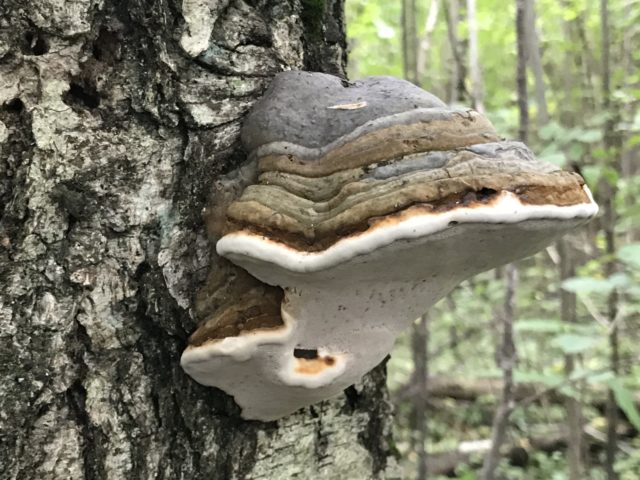
Tinder real
Comment! If real and false tinder fungi settle on the same tree, mutual competitive behavior is observed between them, the result of which is blocking, suppression of the latter.
Reishi Mushroom (Ganoderma lucidum)
Synonyms:
Lacquered polypore, or lacquered Ganoderma (lat.Ganoderma lucidum) is a mushroom of the genus Ganoderma (lat.Ganoderma) of the Ganoderma family (lat.Ganodermataceae).
Lacquered polypores are found in almost all countries of the world at the base of weakened and dying trees, as well as on dead deciduous wood, very rarely on coniferous wood. Occasionally, varnished tinder fungus is found on living trees, but more often fruiting bodies are found on stumps, not far from the soil surface. Sometimes basidiomas grown on tree roots buried in the ground can be found directly on the soil. From July to late autumn.
The cap is 3-8x10-25x2-3 cm, reniform or almost ovoid, flat, very dense and woody. The skin is smooth, shiny, uneven, wavy, divided into many concentric growth rings of different shades. The color of the cap varies from reddish to brown-violet, or (sometimes) black with a yellowish tinge and clearly visible growth rings.
The leg is 5-25 cm in height, 1-3 cm in ∅, lateral, long, cylindrical, uneven and very dense. The pores are small and rounded, 4-5 per 1 mm². The tubules are short, ocher. The spore powder is brown.
The pulp is ocher-colored, very tough, odorless and tasteless. The pulp is spongy at first, then woody. The pores are whitish at first, turn yellow and brown with age.
The mushroom is inedible, it is used exclusively for medical purposes.
Spreading
Lacquered polypore - saprophyte, wood destroyer (causes white rot). It is found in almost all countries of the world at the base of weakened and dying trees, as well as on dead deciduous wood, very rarely on coniferous wood. Occasionally, varnished tinder fungus is found on living trees, but more often fruiting bodies are found on stumps, not far from the soil surface. Sometimes fruiting bodies grown on tree roots buried in the ground can be found directly on the soil. During growth, the mushroom can pick up twigs, leaves and other debris into the cap. In Russia, varnished tinder fungus is widespread mainly in the southern regions, in the Stavropol and Krasnodar territories, in the North Caucasus. In temperate latitudes, it is less common than in the subtropics.
Recently, it has spread widely in Altai, in places of predatory felling.
Season: July to late autumn.
Cultivation
The cultivation of Ganoderma lucidum is carried out exclusively for medical purposes. Fruit bodies traditionally serve as raw materials for obtaining biologically active substances, much less often the vegetative mycelium of this fungus. Fruit bodies are obtained using extensive and intensive technologies. The vegetative mycelium of Ganoderma lucidum is obtained by submerged culture.
The Reishi mushroom is highly prized and cultivated in the countries of Southeast Asia.
Application The mushroom Ganoderma lucidum is one of the famous basidiomycetes used for medicinal purposes for more than two thousand years by the peoples of Southeast Asia. Linzhi is mentioned in many ancient Chinese medical books: "Herbalist Shen Nun" (Shen Nun Ben Cao Qin) "Compendium of Medicinal Substances" and others. The monograph (Ben Cao Gan Mu) describes Linzhi as the "top" medicine, which means - the most precious , a heaven-given remedy for disease. The books also described in detail the characteristics, methods of application and therapeutic actions of Linchzhi: “... the smell is not pungent, the taste is slightly bitter, intended to eliminate overflow in the chest, increase the qi (energy) of the heart, nourish the middle part of the body, strengthen memory. Medicines based on Linzhi dilate the coronary artery of the heart, enrich the blood with oxygen, eliminate coronary heart disease (CHD), prevent myocardial infarction, and normalize cardiac activity. It was used for various diseases, including bronchial asthma, neurasthenia, gastritis, and liver diseases.
Intensive studies of Ganoderma lucidum over the past decades have shown that biologically active substances isolated from this fungus have immunomodulatory, antitumor, antiviral, antibiotic, hypolipidemic, hypoglycemic, hepatoprotective, gene-protective, anti-inflammatory, anti-allergenic, cardiac, antioxidant- , respiratory and nervous systems.
Habitat and shape
Most often, the fungus grows in areas where trees have been felled or forest fires have occurred. If the tree is strong and young, then most likely it will cope with the disease. But old, damaged, but still living trees are highly likely to be infected with a young fungus.
If a false tinder fungus settles on a living plant, then it will begin to feed on its juices until it dies. But even on a dead tree, the fungus lives by decomposing dead wood. It can be seen on stumps, dead wood and even on outbuildings.
A mushroom called false tinder fungus belongs to the polyporous family (from Latin Polyporus). In other words, this family is called tinder basidial from a separate order aphyllophoric (from Latin Polyporales).
The shape of such mushrooms is usually hoof-shaped or one-sided-cap. These are the owners of a structure completely uncharacteristic for mushrooms. The peculiarity lies in the fact that the fruiting body and tubules of polypores are relatively independent of each other during the formation of the fresh hymenial layer.
In general, the family of polyporous fungi is very diverse. It unites more than sixty genera, each of which includes several dozen more species.
The name tinder came from the fact that the fruiting body of such mushrooms was traditionally used to make tinder - a flammable material from any spark. It is also interesting that in the old days they carried fire in tinder fungi.
Most of the aphyllophors parasitize on the branches and trunks of trees, destroying valuable timber and causing significant damage to the national economy.
Polypores rarely grow on soil. They have a tubular hymenophore, and the fruiting bodies have a prostrate, capped or sessile shape. The consistency of the mushroom is fleshy and even tough, corky, woody.
Fruiting bodies in polyporous fungi are formed after several months and even several years after the onset of mycelium development. The bodies themselves are very diverse.
Of interest is the oak tinder fungus growing on the bark of an oak tree. In Latin it is phellinus igniarius, which means smoking cork. Most likely, this name is due to the fact that in terms of the method and form of fastening, the mushroom resembles a wooden cork in the hole of a trunk or branch. Its counterpart is a false oak mushroom tinder fungus.
The influence of false tinder fungi on wood
Pellinus burnt is a very aggressive parasite that causes intense white heart rot. The spores of the fungus penetrate into the wood where the bark is damaged, where the branches are broken, and germinate. During growth, the fungus feeds on lingin and fiber of trees, damaging their core. Extensive decay of wood occurs along the trunk and branches. Outward signs of infection are whitish or yellowish stripes and spots, which subsequently form a yellow-white rot with black closed lines and clusters of reddish mycelium. But often the disease is asymptomatic. Rot penetrates the core, stretching along the entire trunk, outwardly not revealing itself in any way. Weakened wood becomes fragile, defenseless against the effects of winds, rain, drought. The mushroom itself can live for several more years on a dead, withered tree. Polypores are the main cause of tree death in forests and city parks. Losses can be up to 100%.
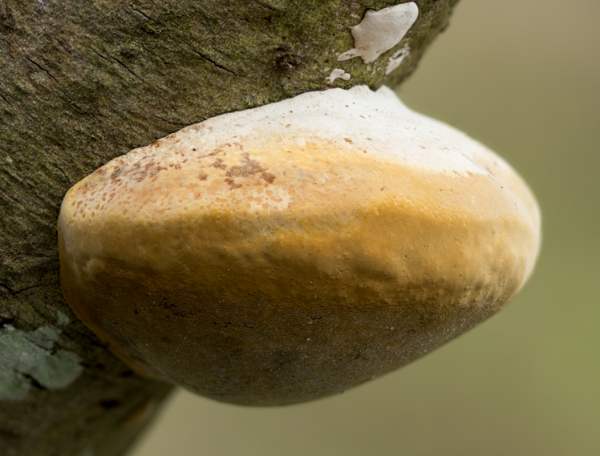
Young false tinder fungus
External description
The fruit body of this mushroom is perennial, its length can be from 5 to 20 cm. At first it has the shape of a kidney, then it becomes spherical, resembling an influx. The tubular layer is convex, rounded, brownish-rusty, layered, with small pores. It is this layer that is the characteristic feature of this fungus. The fruit body grows sideways, it is thick, sessile, and has irregularities and concentric grooves on top. Radial cracks often appear on it. The color of the fruit body is gray-brown or black-gray, the edges are rounded, rusty-brown.
Yellowish spore powder.
The flesh of the mushroom is thick, tough, hard, woody, reddish-brown.
Autumn honey agaric
Autumn honey fungus (Armillaria mellea) is the causative agent of white sapwood (peripheral) rot of roots and trunks. Currently, many researchers consider it not as a separate species of fungi, but as a complex of closely related species, differing in areas, morphological and biological features.
Many conifers and deciduous species, as well as fruit crops are affected. Often, honey fungus occurs as a saprotroph on dry, deadwood and stumps, but under certain conditions it turns into a parasitic way of life and infects living trees and shrubs, causing them to dry out.
Mushroom on the trunk
Autumn honey agaric is widespread in different categories of forest and urban plantings.
- External signs of the disease in conifers are manifested in the thinning of the crown, yellow-green, yellow-brown or brown color of the needles, the presence of cracks and resinification in the butt of the trunks.
- When deciduous species are affected, the crowns of diseased trees become openwork due to crushing of leaf blades. Premature fall of foliage is often observed, cracks form in the butt of the trunks, from which a mucous liquid sometimes flows out.
The characteristic modifications of the mycelium (mycelium) in the form of films and rhizomorphs and fruiting bodies (basidiomas) are reliable signs of autumn honey fungus.
White fan-shaped films form under the bark of thick roots and trunks, covering a significant part of their surface. At first they are thin, but over time they thicken, turn yellow, partially split and transform into rhizomorphs.
- Rhizomorphs develop under the bark of roots and trunks and on the surface of the roots.
- Subcrustal rhizomorphs have the appearance of dark brown, flat, branching cords.
- The outer rhizomorphs are dark brown, almost black, rounded in cross section, similar to the roots of higher plants. They spread up to 30 m and infect healthy roots. Outside rhizomorphs can also move from infected roots to healthy ones through the litter.
Rhizomorphs of the mushroom
The most active development and distribution of rhizomorphs occurs at high humidity and temperatures from +17 ° C to 25 ° C.
Fruiting bodies (basidiomas) of autumn honeydew have the appearance of annual caps on a central leg. Caps are convex or flat, often with a tubercle in the center, yellowish brown, grayish brown, covered with darker scales. The hymenophore is lamellar, white.Stem up to 10-15 cm long, slightly thickened at the base, light brown, fine-scaled, with a white fluffy ring under the cap. Fruiting bodies are formed in groups on old stumps, deadwood and dead wood trunks. In very rare cases, basidiomas can be found on the roots and at the base of the trunks of affected living trees.
Honey mushroom films
The basidiospores formed on the hymenophore plates are spread by air currents, rainwater, animals and infect stumps and roots. The most active formation of basidiospores, their scattering and infection occurs at the end of summer - in autumn in humid warm weather.
Autumn honey fungus affects woody plants, as a rule, against the background of their preliminary weakening caused by various unfavorable factors (weather conditions, damage by other diseases, damage by pests, industrial air and soil pollution, etc.).
Natural significance and role in forestry
Aspen tinder fungus is highly harmful, destroying most of the commercial timber. It spreads in most areas of aspen, causing premature death of trees. However, there are some species of aspen with a certain degree of resistance to the parasite. The polypore slowly kills the tree (over ten years or more), prolonging its existence and increasing the number of spores formed. However, even in the initial stages of damage, wood loses its commercial qualities, its class falls. The fungus affects aspen mainly at the age of 30 ± 5 years. Thus, technical felling trees are threatened.
Back to content
Description
Fruit bodies are perennial (they can grow for tens of years), sedentary, rounded in youth, then acquire a characteristic hoof-like appearance. Sometimes they are cushion-shaped or flat, extended in shape. The fruiting body is very firmly attached to the trunk of the affected tree, this is a false tinder fungus differs from the present tinder fungus. The stem of the mushroom is missing. Cracking is quite common in fruiting bodies, the presence of radial cracks is characteristic. The tissue of the fruit body is very hard, woody, reddish-brown, rust-colored or chestnut-brown.
The cap is medium in size, reaching 20-26 cm in width in old mushrooms. The skin is matte, uneven, with concentric ridges. The color of the cap varies from dark gray to almost black or brownish black in old mushrooms. The outer (growing) ridge sometimes has a more noticeable brownish tint.
The hymenophore is tubular, inside the same color as the tissue. Each year, a new layer of the hymenophore grows, and the old layers eventually become overgrown with white hyphae. Outside, the surface of the hymenophore is from rusty brown to deep chestnut color.
Spore powder is light, whitish, sometimes yellowish.
Spores are round, whitish or slightly yellowish.
Currently, the false tinder fungus is subdivided into several specialized forms (subspecies), slightly differing in morphological characteristics, confinement to parasitism on a certain tree species and microscopic features. Outwardly, the individual forms practically do not differ. The original species, the false tinder fungus (Phellinus igniarius), usually affects birch and alder.

